7 Referral Program Ideas For Growing Your Customer Base (with Examples)

Referral marketing has long been praised as an effective marketing tool to grow your business.
It incentivizes existing customers to sell your products to their family and friends in exchange for a reward.
Why does it work so well?
According to one study, some 69% of consumers are more likely to try a new retailer that gives rewards. Just over two-thirds said these rewards impact how much they spend during a single transaction.
But there’s a lot that goes into creating a successful ecommerce referral program—from the incentives you choose to the way you position rewards.
This guide shares seven smart ideas to start your strategy, complete with referral program examples that show each idea in practice.
In this post, we’ll cover:
#cta-visual-pb#<cta-title>Create your perfect Shopify store today<cta-title>Start building for free with Shogun Page Builder to assemble a fully custom revenue machine.Start building for free now
What is a referral program?
A referral program is a type of campaign that rewards existing customers for getting their friends and family members to buy.
If a customer refers a friend, for example, merchants reward them (and sometimes the person they’ve referred) with a cash discount, mystery gift, or charity donation on their behalf.
Referral marketing works because 93% of people trust recommendations from their family and friends—beating review sites, company websites, and social media platforms.
A referral program provides many other benefits for ecommerce merchants, including:
- Cheaper customer acquisition costs. The cost to acquire a customer has increased 222% over the last decade. Referral marketing, however, encourages loyal customers to promote your products. You don’t pay customer acquisition costs upfront—just when the referred customer makes a purchase, and you hand out the reward.
- Increased customer retention. The incentive attached to your referral program can be tied to a future purchase. If customers get 10% off their next purchase when referring a friend, for example, you’re providing existing customers a reason to continue shopping with you. These retained customers are among the most profitable customer segments—they spend 67% more than first-time customers.
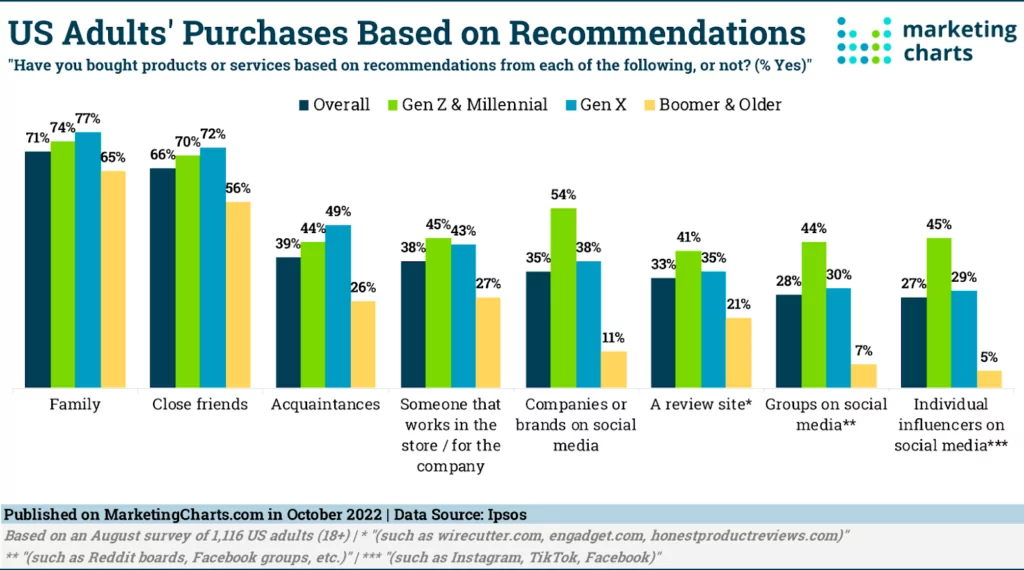
Types of referral programs
Referral programs work using one (or more) of the following formats:
- Direct referrals. This type of referral happens when someone talks about your product with a family member or friend. Also known as word of mouth marketing, merchants facilitate these direct referrals by giving existing customers a personalized code or referral link that the business can attribute sales to.
- Email referrals. An email referral works when people send a branded invitation to a family or friend. It’s a smart way for brands to build their mailing list. (Just check you’ve got the referred friend’s explicit permission to email them beforehand.)
- Social media referrals. With this type of referral, brands encourage existing customers to promote their products on social media. It’s a smart strategy that increases brand awareness—even if new customers don’t buy through a referral link.
7 customer referral program ideas (with examples)
Now that we know the structure of a referral marketing program, let’s explore seven referral marketing strategies other DTC brands have used to grow their customer base.
- Discounts
- Points
- Free upgrades
- Social gifting
- Mystery gifts
- Double-sided incentives
- Tiered rewards
1. Discounts
Discounts have long been the backup strategy for merchants to sell more products.
It makes sense: two-thirds of people would buy something if they had a coupon, no matter whether they initially planned to make that purchase or not.
Appeal to these people—and convince both new and existing customers to take part in your referral program—by making store credit the incentive.
This could be:
- Vouchers
- Cash bonus
- Store credit
- Gift cards
Branch Basics is one DTC brand putting this referral program idea into practice. Customers who refer a friend get $10 store credit to redeem on their next purchase:
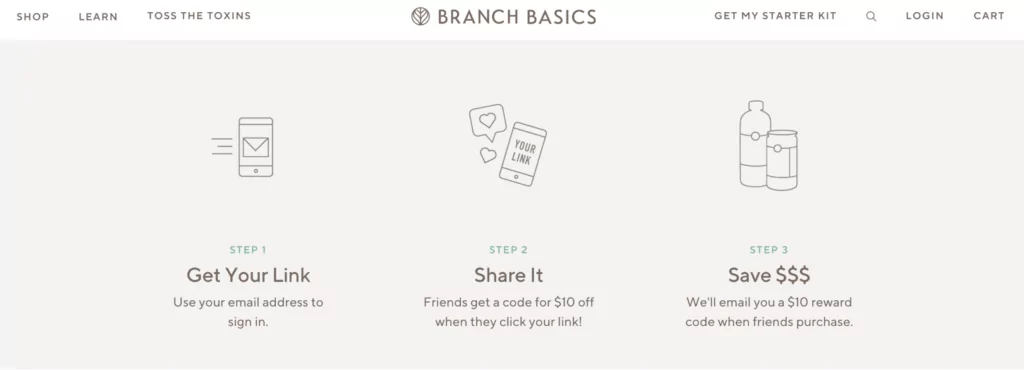
The $10 credit was an incentive customers didn’t want to miss out on.
As a direct result of its refer-a-friend program, Branch Basics generated more than $1.5 million in referral sales, with almost 10% of purchases coming from a referral source.
2. Points
Store credit doesn’t just come in the form of coupons.
A points-based referral program gamifies the entire experience, enticing customers to continue interacting with the brand for bigger and better rewards.
Love Raw, for example, merges its referral marketing program with its customer loyalty scheme. Customers who refer a friend get £10 worth of points.
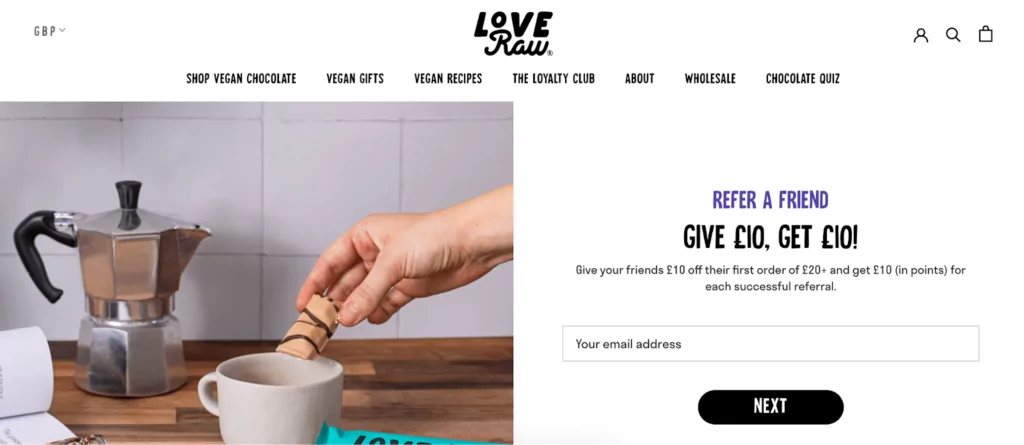
Other actions—like spending more than £50 in a transaction, leaving a photo review, and opting in to SMS marketing—earn the customer more rewards.
This creates a connected experience between the brand and the consumer, fulfilling other marketing objectives like:
- Collecting user-generated content
- Growing its SMS marketing list
- Gathering product reviews
The more points a customer gets, the bigger the discount. And, the best part: its customer retention strategy comes full circle because points can only be redeemed on their next purchase.
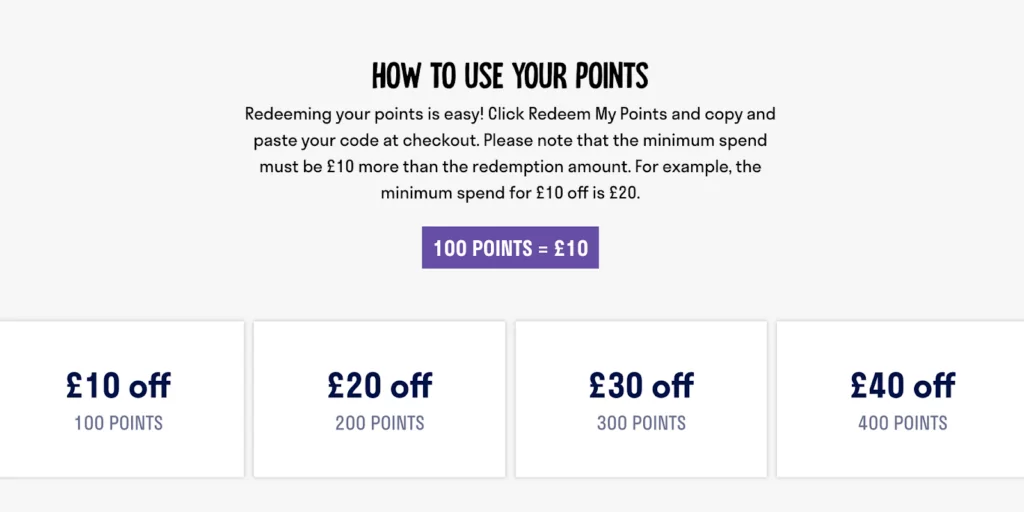
3. Free upgrades
Humans are conditioned to love free things.
Appeal to this desire in your referral campaign by giving referrers a free product—be that an upgrade on the items they’ve bought before, a new free product, or a free miniature sample.
For inspiration on how to implement this referral program idea, look to Riff Raff. Existing customers who refer four new customers to the brand are rewarded with a free sleep toy.

Riff Raff’s decision to only reward customers who refer four friends helps maintain profit margins since they only give a free product once people spend more than a dollar amount.
Customers are also incentivized to continue referring, rather than referring a single friend and losing enthusiasm for the program.
According to its referral marketing platform ReferralCandy, Riff Raff has a referral rate of 24%—ten times higher than the 2.35% industry average. Almost a quarter of its customers come through a referral.
4. Social gifting
One study found that company alignment with personal values is 74% more important to consumers today than last year.
Help new and existing customers feel good by baking social responsibility into your referral program.
The key to success with a charitable referral campaign is to choose a cause your target customers connect with.
Take the dog food business Butternut Box, for example.
The subscription company gives customers 50% off their next box when they refer a friend. They also donate one meal to a sheltered dog—something its dog-loving customers can empathize with.
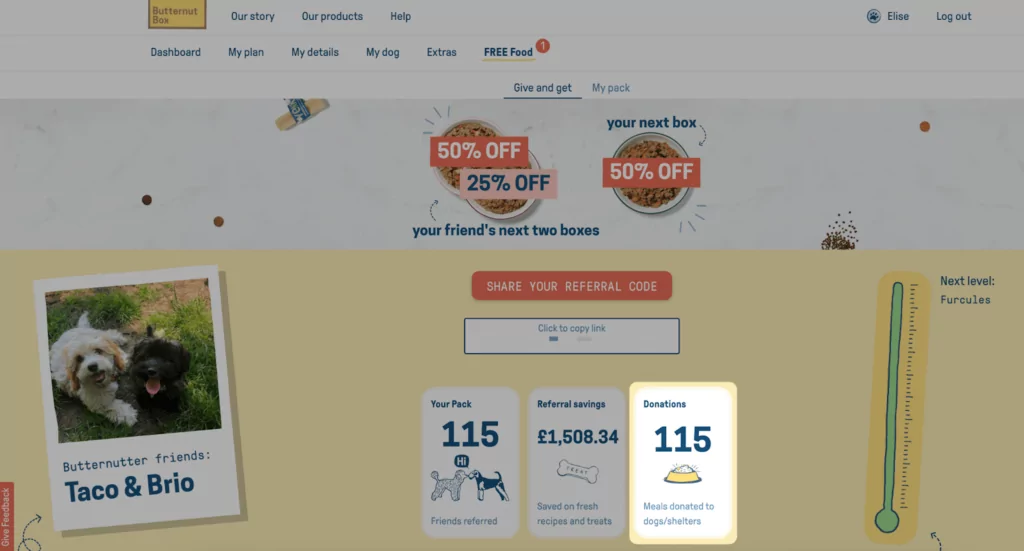
Mattress brand (and Shogun customer!) Leesa, on the other hand, gives customers the freedom to choose the charity closest to their heart.
People who refer a friend can either take the $50 cash or donate it to a nonprofit of their choice.
“Consumers place a tremendous value in the word-of-mouth referral from a trusted friend. We knew the importance of building word-of-mouth into the product experience.”
— Matt Hayes, head of ecommerce at Leesa (via ReferralCandy)
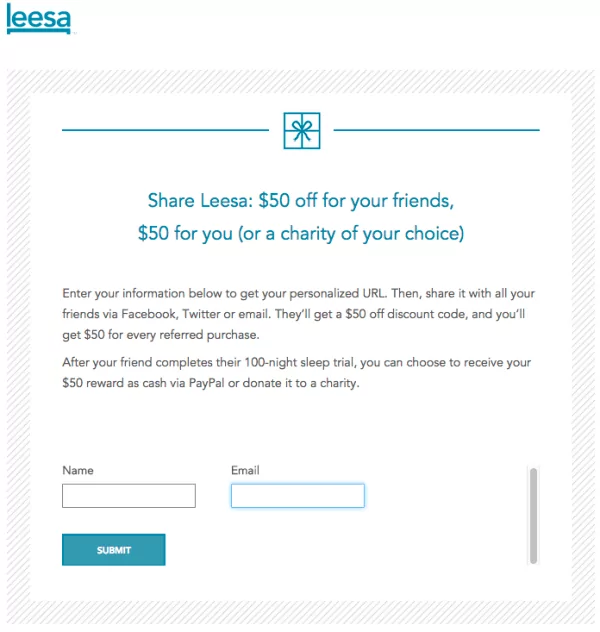
#cta-visual-pb#<cta-title>Your Shopify store could look this good<cta-title>Try Shogun for free and start building out your perfect store to create a totally unique customer experience. Start building for free
5. Mystery gifts
Create an element of surprise with your referral program by enticing customers with a free gift.
Software companies like Freetrade have relied on this referral program idea to generate new customers and retain existing ones. The personal finance tool rewards customers who take part in its referral process with a free share.
Build on this idea for your own ecommerce referral program with mystery gifts like:
- Mini samples
- Free products
- Templates or guides
- Branded swag
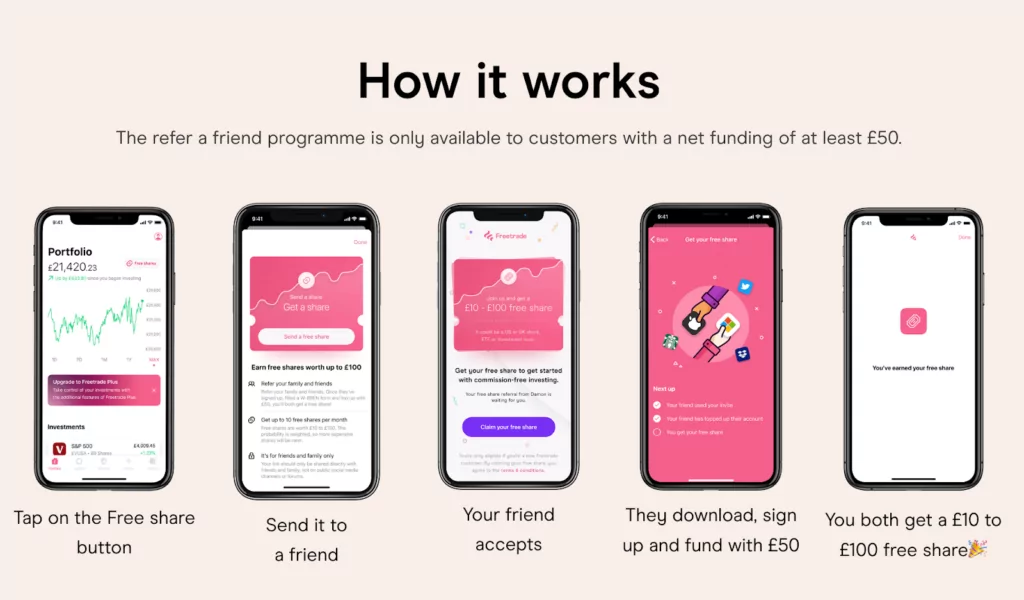
6. Double-sided incentives
A common mistake brands make when creating their referral program is only rewarding the customers who make the referrals.
Giving the referred customer an incentive—be that a free product, discount, or mystery gift—gives potential customers a reason to try your brand.
The double-sided incentive also makes it easier for current customers to refer a friend and claim their reward.
It’s a win-win for everyone involved. (When that happens, the ROI of your referral program is bound to explode.)
Rumpl, for example, is a Shogun customer that offers a double-sided referral program through its ecommerce store. The referred friend gets $15 off their first purchase; the existing customer gets the same discount on their next order.
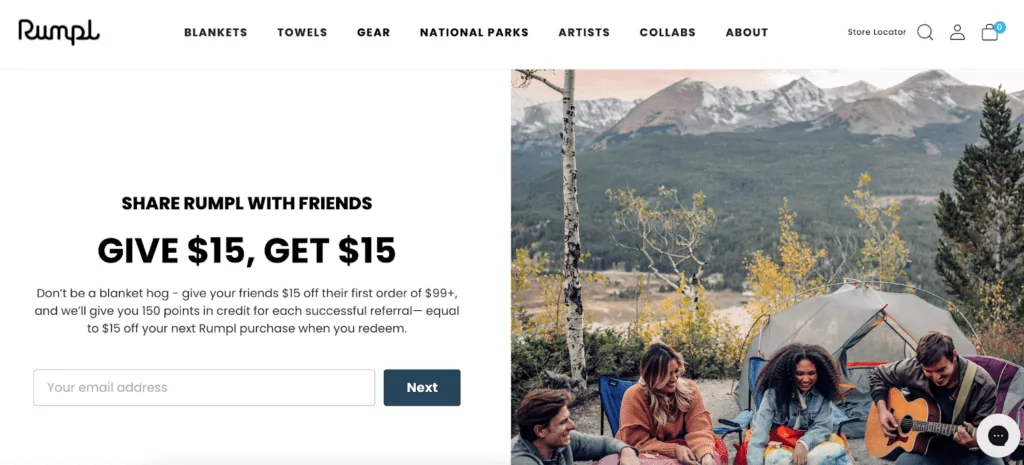
7. Tiered rewards
The referral reward ideas we’ve shared so far do a great job of convincing existing customers to refer a friend.
But the best campaigns encourage people to continue taking part long after the first dopamine hit.
Revolution Beauty uses this structure for its tiered referral program, RevRewards. Customers earn points for referring a friend alongside completing specific touchpoints with the brand, like downloading its app or leaving a review.
Customers reach levels after earning a set number of points.
Its premier tier, Gold, requires customers to earn 400 points (the equivalent of referring four new customers). Gold tier members get free gifts, free delivery, and VIP access to member-only promotions.
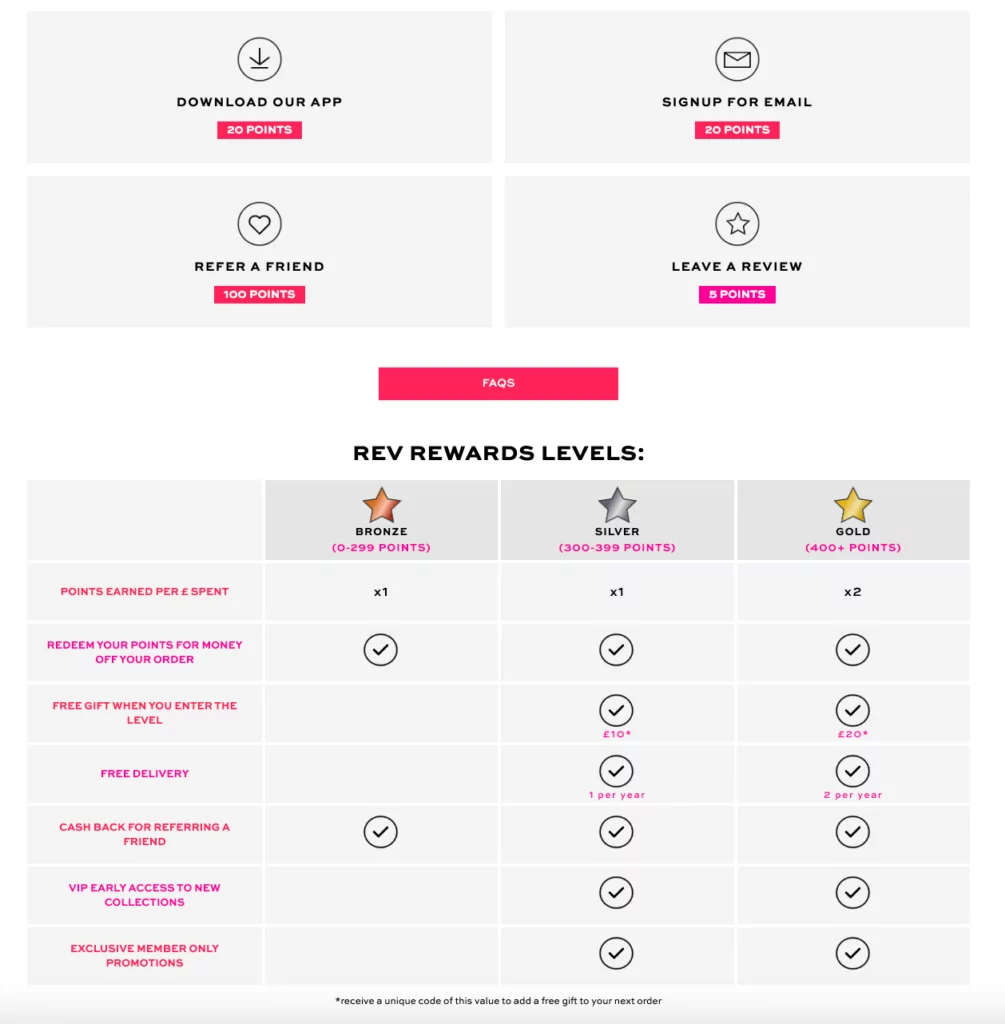
After implementing its customer loyalty and rewards program, Yotpo, the brand’s software partner, reported incredible retention results.
Revolution Beauty saw a 234% increase in repeat purchase rate and a 44% uplift in average order value as a result of its program.
How to create a successful referral program
Once you’ve drawn inspiration from the referral program ideas above, let’s move on to how you can implement a referral program for your DTC brand.
Determine the referral incentive
The first step in creating a referral program is to determine the incentive you’ll use.
Explore the ideas we shared in the first part of this article and find the one that best suits your products and customer goals.
“People will be more willing to sign up if your incentives are good. These incentives shouldn’t be enticing for them alone, but also for those they are referring to.”
— Guillaume Drew, founder of Or & Zon
Best practices for choosing a referral incentive include:
- A reward your customers care about. Ask your audience to see which rewards appeal to them. If you’re a children’s skincare brand, for example, you might find existing customers get more fulfillment by donating their referral to a local children’s charity than by claiming a $5 reward themselves.
- Low barrier to entry. Make the first reward in your referral program easy to achieve. People are turned off by tasks that require too much effort. If you’re waiting for current customers to make five referrals before getting their first reward, you could be losing out on customers otherwise willing to spread the word.
- Not sabotaging profit margins. Since referral programs often have a lower customer acquisition cost than traditional marketing campaigns, it’s tempting to give away an incredible incentive. Check your product profit margins to guarantee you’re not losing more money than the referred customer spends—especially if it’s a double-sided incentive.

Choose a referral management platform
Most ecommerce platforms—including Shopify and BigCommerce—don’t come with built-in referral program features.
However, there are several apps that integrate with those ecommerce platforms to allow merchants to run their own referral programs.
Look for a platform that allows customers to generate referral links, track the number of referrals they’ve made, and view payouts or rewards.
Popular options include:
Create a landing page
Referral programs need great landing pages to attract customers. The messaging has to be targeted, and the page design needs to drive visitors to action.
“Pay your people well, don’t be swayed by the number of followers, and think of it more as UGC with sales as a side benefit.”
— Elyse Kaye, founder and CEO of Bloom Bras
Draw inspiration from Allplants’ referral landing page.
Above the fold, visitors see its referral program sign-up form (powered by Mention). The incentive to join its program is clear, and the contrasting CTA button draws the visitors’ attention to the desired outcome of its ecommerce landing page:

Beneath this sign-up form is a bunch of social proof to reiterate the brand is worthy of a referral.
Customers see Allbirds’ 5-star TrustPilot rating, B-Corp badge, and answers to frequently asked questions related to the referral scheme.
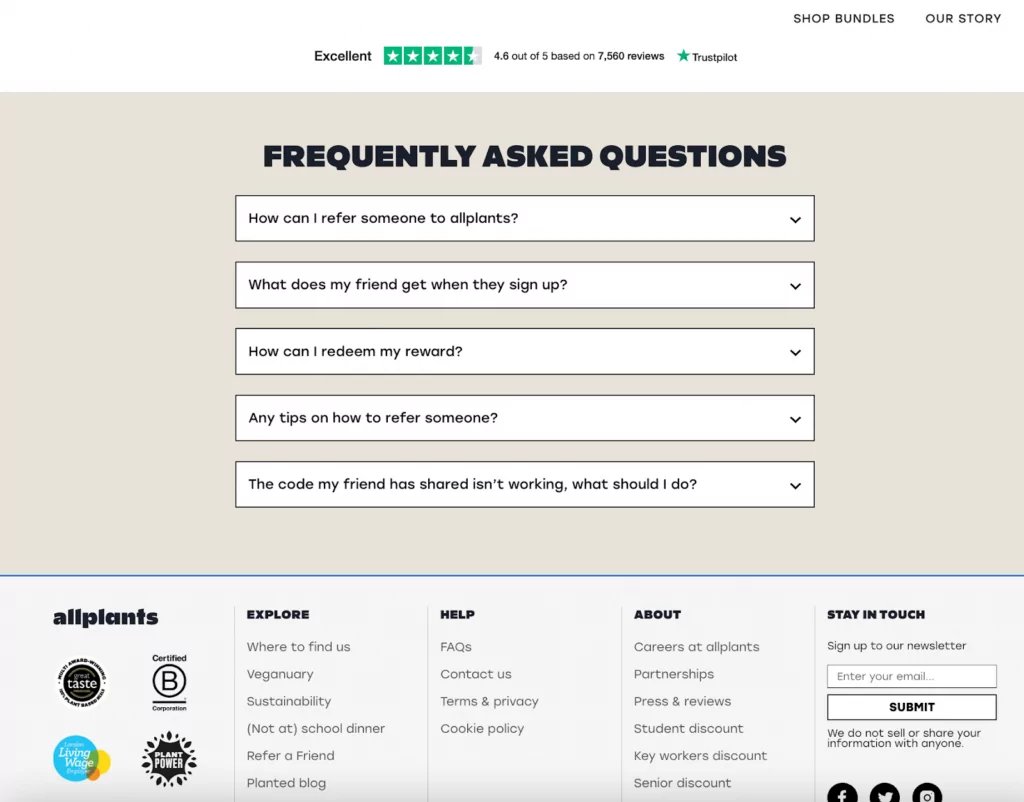
#cta-mini-pb#Want to learn more about Page Builder? Learn more
Invite customers to refer a friend
Once your referral program is set up and your landing page is optimized to convert customers into active referrers, it’s time to spread the word.
Marketing ideas to promote your referral program include:
- Use email marketing and SMS campaigns to invite existing customers to join your referral program. Configure a post-purchase automated series that invites future customers to refer a friend 14 days after their first order.
- Retarget previous customers on social media and promote the incentive on offer when they refer a friend.
- Target customers actively looking for your referral program in organic search results by optimizing the landing page for “[brand] referral program” or “[brand] refer a friend”.
- Use push notifications to encourage customers to refer a friend when they’re signed into their online account.
Devin Stagg, marketer at Pupford, says: “We’ve found the most effective way to encourage customers to take part in the referral program is by talking about it in multiple places.
“After each order they’re shown information about the program on the thank you page, in a post-purchase email, and even within their account dashboard. The key has been to keep it top of mind.”

Bloom Bras, on the other hand, keeps its referral program more discreet. Founder and CEO, Elyse Kaye, says:
“Our referral program has been word of mouth and invitation only. We are very focused on diversity so that is the driving factor. If someone is making relevant content, we want them to be a part of the family. They get an email explaining the program, guidelines, and a specific code.”
“The landing page is optimized with images showcasing the bra for inspiration,” Elyse continues. “We have groups of women in certain cities that have organized photoshoots. It is really about community and empowering women of shapes and sizes and stages of life to feel good moving.”
Track the results of your referral program
Do you know whether your ecommerce referral program is meeting its objectives? Most merchants create their programs to improve customer retention and acquire new customers.
Regularly benchmark the following metrics to prove whether you’re making headway on those goals:
- Referral participation rate. This is the percentage of people who’ve joined your referral program out of all those invited. The higher this figure, the better—it indicates that people love your products enough to envision themselves referring a friend. It’s also a good indicator that your incentives and landing page resonate with customers.
- Average referral count and conversion rate. This is the average number of people a single customer refers and the percentage of visitors who convert after clicking a referral link. If this is lower than you’d like, provide existing customers with an asset library of key product messaging, images, and templates they can use to convince friends and family to buy.
- Customer lifetime value. If your referral program is designed to increase customer retention, monitor the difference in this metric. An increase in LTV for those who have taken part in your referral program means the incentive is good enough to keep them engaged.
Referral program idea FAQs
What should be included in a referral program?
Every referral needs some kind of reward that convinces existing customers to participate. Also known as an incentive, popular options include cash discounts, free upgrades, or points to redeem on their next purchase.
How do you reward customers for referrals?
1. Cash discounts
2. Gift cards
3. Free upgrades
4. Charity donations
5. Mystery gifts
6. Points to redeem on future purchases
What is a good referral rate for ecommerce?
Referral rate is the percentage of orders that come from a referred customer. Studies put the average referral rate for ecommerce merchants at 2.35%. Anything above this benchmark is considered a good referral rate.
How do you ask customers for referrals?
Email is a great way to encourage customers to take part in your ecommerce referral program. Create an automated invite that triggers around two weeks after each purchase—that’s just enough time for them to see value and still be excited about your product.
What is the difference between an affiliate and referral program?
Both affiliate and referral programs incentivize people to recommend your products to their networks. However, the biggest difference between the two is that affiliates aren’t always customers of your brand.
People who join your referral program are existing customers who can vouch for your products, often making them the most effective type of referral marketing.
Are referral programs worth it?
Yes! A referral program is a cost-effective way to not only acquire new customers but retain existing ones, too—especially if the reward for referring a friend is a discount to redeem on their next purchase.
Do referral programs increase sales?
Referral programs can increase sales because new customers have two compelling reasons to buy from you.
First, someone they trust recommends the product. Second, merchants offer incentives for people to buy through referral links—be that a percentage discount or a mystery gift.
Referral programs also have the ability to increase sales from existing customers, especially if the incentive they’re given can only be redeemed on another purchase.
Promote your referral program with a high-converting landing page
The best referral programs turn happy customers into brand evangelists.
Use the ideas we’ve shared here to incentivize loyal customers to refer a friend. Whether it’s a cash discount, mystery gift, or free upgrade, you’ll monetize existing customers while also finding new ones on autopilot.
#cta-visual-pb#<cta-title>Build high-converting landing pages<cta-title>Try Shogun for free and start building impressive landing pages for your referral program. Start building for free

Elise Dopson
Elise Dopson is a freelance writer for B2B commerce and martech companies. When she's not writing, you'll find her in the Peak Freelance community or on Twitter.



